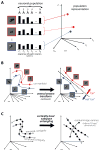How does the brain solve visual object recognition?
- PMID: 22325196
- PMCID: PMC3306444
- DOI: 10.1016/j.neuron.2012.01.010
How does the brain solve visual object recognition?
Abstract
Mounting evidence suggests that 'core object recognition,' the ability to rapidly recognize objects despite substantial appearance variation, is solved in the brain via a cascade of reflexive, largely feedforward computations that culminate in a powerful neuronal representation in the inferior temporal cortex. However, the algorithm that produces this solution remains poorly understood. Here we review evidence ranging from individual neurons and neuronal populations to behavior and computational models. We propose that understanding this algorithm will require using neuronal and psychophysical data to sift through many computational models, each based on building blocks of small, canonical subnetworks with a common functional goal.
Copyright © 2012 Elsevier Inc. All rights reserved.
Figures






References
-
- Abbott LF, Rolls ET, Tovee MJ. Representational capacity of face coding in monkeys. Cerebral Cortex. 1996;6:498–505. - PubMed
-
- Adelson EH, Bergen JR. Spatiotemporal energy models for the perception of motion. J Opt Soc Am A. 1985;2:284–299. - PubMed
-
- Afraz SR, Kiani R, Esteky H. Microstimulation of inferotemporal cortex influences face categorization. Nature. 2006;442:692–695. - PubMed
-
- Aggelopoulos NC, Rolls ET. Scene perception: inferior temporal cortex neurons encode the positions of different objects in the scene. Eur J Neurosci. 2005;22:2903–2916. - PubMed
Publication types
MeSH terms
Grants and funding
LinkOut - more resources
Full Text Sources
Other Literature Sources
Medical

